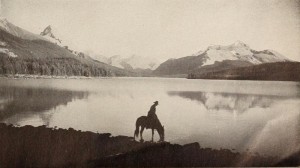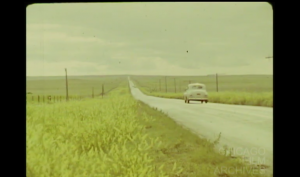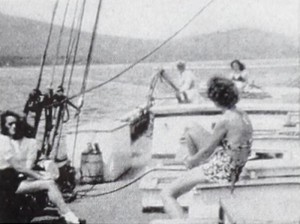
"Western Holiday offered one of those thrills in the sequence of sunrise on Mount Robson. Here Kodachrome caught, with what seemed magic, the first rosy glow on the cold, blue snow, which the continuity of photographic motion permitted to increase, to blossom and, finally, to blaze into a chromatic crown of jewels. To see this on the screen is to enjoy a rare experience. Hamilton H. Jones, in the highly intelligent cutting of his train sequences, gave the student of continuity another of these thrills. Those who are charmed by double turntable accompaniment will recognize the perfection with which an almost impossibly difficult feat of lip synchronization with record scoring has been handled. These are some of the higher spots in a film of unusually high general average. Mr. Jones is a Kodachrome movie maker of proved ability, who has made editing a special art. The film chosen for the first Hiram Percy Maxim Memorial Award will be used by Mr. Jones in his work as a lecturer on the vacation advantages of the Dominion of Canada, although it was made as his own enterprise, entirely at his own expense and not for compensation from a client. It is a part of his professional equipment. Briefly reviewed, Western Holiday carries the audience, via Canadian National Railways, from Victoria, Canada's most westerly metropolis, across the Rocky Mountains back to the Eastern Seaboard. Beginning with city views in Victoria and Vancouver, with strikingly colorful parades of the famous Canadian Mounted Police, we visit tourist centers and make trail trips from them. The camera goes into the interior of a glacier, it finds mountain goats and sheep, it clambers over the Continental Divide on horseback. All through the trip, it studies the progress of trains, weaving in and out of tunnels and over bridges. In his personal presentations of this film, Mr. Jones manipulates effects, such as whistles, bells, train noises and other oddments, with something approaching wizardry. In the face of competition of the highest order, Western Holiday is its own justification of preferment." Movie Makers, Dec. 1937, 602.

"Edited footage of western scenery on a road trip to Yellowstone Park. Includes scenes of camping and numerous landscapes, Mount Rushmore and the various grounds of Yellowstone with their hot springs and geysers." Chicago Film Archives

"Sidney Moritz likes to record the few vestiges that remain in this rapidly changing country of the days that were. After earlier voyages on an Ohio River "sternwheeler," he made two cruises on the Mattie, an old schooner that now hugs the New England coast and carries vacationers. In Windjammer there is cinematic beauty, with delightful scenes of masts and sails. There is also a detailed and very human record of the way in which the holiday makers — who also help with the ship's chores — enjoy a recreation both salty and salubrious. One is sure that they and the ship's crew — including grim old Captain Grant — had a grand time. Mr. Moritz must have had one, also, if his gay footage reflects his mood." Movie Makers, Dec. 1945, 497.
Total Pages: 12